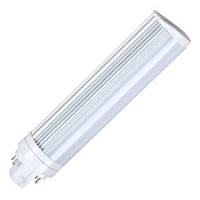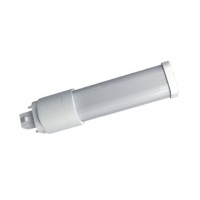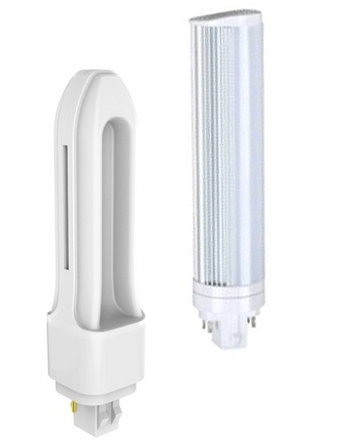This post has been updated from its original version.
PL lamps, given their name by their originator, Philips Lighting, have been in the game for many years now. These pin-based lamps are widely used and installed in a variety of fixtures, from recessed cans, outdoor fixtures, and ceiling fans, to table lamps and wall sconces. They’re used in both residential and commercial buildings across the country. Like most energy efficient lamps, these were first introduced in compact fluorescent format. While CFLs will always be the better choice over incandescent lamps, by considering CFL to LED conversion, you’ll discover an entirely new range of benefits. Just think of it as leveling up.
Dollars and Sense
For starters, let’s look at wattage. The wattage amount used by a bulb measures how much energy it consumes to illuminate the room. LED PL lamps that use only 12 watts of energy can replace CFL PL lamps that consume 26 watts. By switching out just one bulb, you’re cutting the energy consumption, and equally the costs, for that one bulb by more than half. LED lamps have been made to replace 13, 18, 26 , 32 and 48-watt CFL bulbs.
In addition to saving money long-term, LED technology is such that it removes the glow and flicker that is so commonly associated with fluorescent lighting. The LED lights provide instant-on lighting, and warm up in no time at all. While CFLs typically come with a 5 year warranty and 10,000 hour lifetime rating, their LED counterparts have warranties upwards of 10 years, and are rated to last 50,000 hours on average.
Battle of the Ballast
When shopping for PL lamps, you may notice some are labeled Plug and Play while others are labeled Ballast Bypass. Plug and play lamps attach directly into the socket of your fixture and operate using the ballast that’s already there. No additional wiring is required, making the transition both smooth and simple.
Rewiring is necessary to install ballast bypass LED PL lamps, as the existing ballast has to be removed. They are, however, a great choice for anyone wanting a lamp that will call for less maintenance. Each type is available in horizontal and vertical design for illumination in both commercial and residential environments.
Bulb Base and Basics
PL lamps come in multiple color temperatures and either a 2-pin led bulb or 4-pin led bulb configuration. All have a base of either GU24, G24 or GX23. You’ll want to pay careful attention to these details in order to avoid getting the wrong bulb for your fixtures. They come in color temperatures that range from the warm 3000K to a cool 5000K. The warm, or soft glow at the beginning of the spectrum is ideal for living areas. The cooler light is what is typically found in office buildings, schools, and hospitals. Once you’ve chosen your wattage, ballast, base, and color, you’ll be good to go! You’ve already switched from incandescent to CFL. Now committing to CFL to LED conversion just got a little easier.





Hoping maybe someone can help me out
I am looking for a replacement bulb for the following
LEDOne : model LOD-BHPL-7W50K
It needs to be daylight or close
Great and succinct article. It should be pointed out that led bulbs generate very low quantities of heat-another benefit during summer months and high use of air conditioning. Our handypersons can help upgrade all those bulbs especially in high ceilings safely. See our us at https://www.humblehandymanservices.com